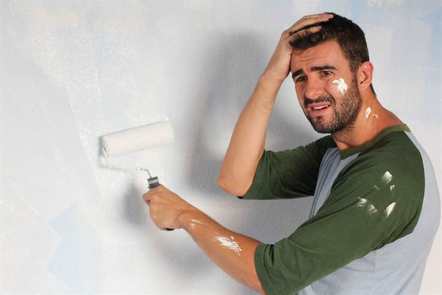You’re thinking of renovating your house; you look around you, and see that the paint, inside and out, doesn’t look as good as it once did. There’s all sorts of deformities and cracks lining your walls, and you start to wonder what they all are, and how they all got there. There’s a myriad of potential paint problems, each with their own cause and solutions; here’s a few of them.
Paint bubbles, also known as blisters, are caused by some combination of moisture and heat creating a lift between the paint and the surface it’s covering. The conditions that can create paint bubbles include applying oil or acrylic paint over latex paint, painting damp, impure or hot surfaces, and improper surface preparation. Generally, bubbles are best prevented rather than repaired; repairing bubbles without confronting the underlying problem will cause more blisters to appear. Avoid painting in hot and humid conditions, and have high-quality house painting done by professionals to decrease the likeliness of bubble-causing errors.
Cracking is common in many households; it is often caused by paint that has lost its flexibility to age. The natural expanding and contracting of your home due to changes in humidity will split paint that is too rigid. Cracking can also be caused by improper paint application and surface preparation. Alligatoring is a specific type of cracking where the cracks begin to form a pattern similar to an alligator’s scale; this is often caused by using a rigid paint over top of a more flexible paint. Cracking and alligatoring, left untreated, can lead to flaking, where the paint literally begins to flake off of the substrate. You will need to remove the paint and re-apply in the case of excessive cracking and peeling; once again, prevention is best, and hiring a professional will help you avoid cracking in the future.
Brush and roller marks are caused by inexperienced painters going over a surface after it’s already dried, using the wrong brushes or overworking paint. These marks are unsightly, and are again best avoided by contacting a professional.
Fading and discoloration can be caused by excessive sunlight burning away the pigment in the paint; it can also be caused by using interior grade paints outdoors. Interior grade paints are designed with less sun resistance in mind, so they don’t last well on your home’s exterior. Temperature fluctuations and moisture while paint is drying can cause flashing, which is a term for fading that occurs unevenly, but may also be caused by poorly applied paint and improper surface preparation.
The theme for all of the common paint problems is that the paint wasn’t properly applied or mixed, and that the surface wasn’t properly prepared, or that the wrong paint is used for the wrong surface; all errors that can be remedied simply by ensuring you always hire a professional to paint your house. House paint is an inexpensive way of increasing your home’s beauty and value, but only if you do it right.
Paint bubbles, also known as blisters, are caused by some combination of moisture and heat creating a lift between the paint and the surface it’s covering. The conditions that can create paint bubbles include applying oil or acrylic paint over latex paint, painting damp, impure or hot surfaces, and improper surface preparation. Generally, bubbles are best prevented rather than repaired; repairing bubbles without confronting the underlying problem will cause more blisters to appear. Avoid painting in hot and humid conditions, and have high-quality house painting done by professionals to decrease the likeliness of bubble-causing errors.
Cracking is common in many households; it is often caused by paint that has lost its flexibility to age. The natural expanding and contracting of your home due to changes in humidity will split paint that is too rigid. Cracking can also be caused by improper paint application and surface preparation. Alligatoring is a specific type of cracking where the cracks begin to form a pattern similar to an alligator’s scale; this is often caused by using a rigid paint over top of a more flexible paint. Cracking and alligatoring, left untreated, can lead to flaking, where the paint literally begins to flake off of the substrate. You will need to remove the paint and re-apply in the case of excessive cracking and peeling; once again, prevention is best, and hiring a professional will help you avoid cracking in the future.
Brush and roller marks are caused by inexperienced painters going over a surface after it’s already dried, using the wrong brushes or overworking paint. These marks are unsightly, and are again best avoided by contacting a professional.
Fading and discoloration can be caused by excessive sunlight burning away the pigment in the paint; it can also be caused by using interior grade paints outdoors. Interior grade paints are designed with less sun resistance in mind, so they don’t last well on your home’s exterior. Temperature fluctuations and moisture while paint is drying can cause flashing, which is a term for fading that occurs unevenly, but may also be caused by poorly applied paint and improper surface preparation.
The theme for all of the common paint problems is that the paint wasn’t properly applied or mixed, and that the surface wasn’t properly prepared, or that the wrong paint is used for the wrong surface; all errors that can be remedied simply by ensuring you always hire a professional to paint your house. House paint is an inexpensive way of increasing your home’s beauty and value, but only if you do it right.



